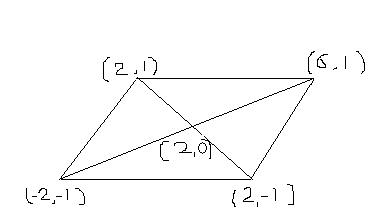You have give the sample problem. It's correct answer is the coordinate (-2,1). But you have chosen the correct answer is d. I can't find any explanation about it.
the 3 coordinates of a parallelogram are (-2,-1), (2,-1), (2,1), find fourth
-
UP 0 DOWN 0 0 7

7 Answers

(6,1) can be a possible coordinate along with (-2,1)but how other options are possiible
If they are taken in order then....
Let, ABCD be the four co-ordinates of the parallelogram
where, A = (-2,-1) , B = (2,-1) , C = (2,1) and D = (x,y)
Now, u know that, diagonals of a parallelogram bisect each other.
so, Mid point of AC = Mid point of BD
=> [(x+2)/2,(y-1)/2] = [(0,0)]
so, x + 2 = 0 and y - 1 = 0
=> x = -2, y = 1
Hence, (-2,1) is the required possible answer
The answer can be different if we take the coordinates in some other fashion....
like in the question, we're given that these are the three co-ordinates of
a parallelogram. But its not mentioned that "they are taken in order".
so, there can be three possible answers as i guess..
:D
There are 6 possible answers only if order of them is not given
It has to be solved using that opposite sides of parallelogram are equal(they are many ways to solve this question by using any property of parallelogram and distance formula)
In my method i am taking that opposite sides of parallelogram are equal
After applying this and distance formula a very easy conclusion comes
that in a parallelogram ABCD if co-ordinates of A,B,C are given to find fourth just add the co-ordinates of A and C and subtract B from it.
(i.e add opposite co-ordinates and subtract the third one from it
It is the easiest method
Going by it
IF
A = (-2,-1) , B = (2,-1) , C = (2,1) and D = (x,y)
Then x =( -2 + 2 ) - 2 = -2
y = (-1 +1) -( -1) = 1
If
A = (2,-1) , B = (-2,-1) , C = (2,1) and D = (x,y)
Then x =( 2 + 2 ) - (-2) = 6
y = (-1 +1) -( -1) = 1
etc
:)
How 6??
There will be 3 possible answers
suppose the known coordinates are,
(a,b) , (c,d) , (e,f)
so, there are only three cases,
(a,b) - > (c,d)
(c,d) - > (e,f)
(e,f) - > (a,b)
what else??
As, (a,b) -> (e,f) ~ (e,f) -> (a,b)
i hope u understand.... :D
oh sorry by mistake typed 6. I know it is 3 . It will be 3 only .I am very sorry for that :(